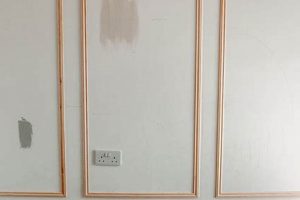The process of installing wooden panels on walls as a do-it-yourself project involves a series of steps, beginning with careful measurement and planning, material selection, precise cutting, secure attachment to the wall, and finishing touches like caulking and painting or staining. An example is a homeowner choosing and installing shiplap boards to create an accent wall in a living room without professional assistance.
Implementing this type of home improvement offers various advantages, including enhancing a room’s aesthetic appeal, providing insulation benefits, and increasing a property’s value. Historically, this interior design approach has been employed across different cultures and eras, reflecting changing architectural styles and material availability. This method allows for personalized expression within a living space while potentially reducing reliance on professional contractors.
The subsequent sections will address specific considerations for a successful installation. These include selecting the appropriate materials, preparing the wall surface, employing different attachment techniques, and executing the finishing work to achieve a professional result. Careful consideration of each aspect will contribute to the overall quality and longevity of the completed project.
Essential Guidance for Wood Paneling Installation
Implementing a successful wall paneling project requires meticulous planning and execution. The following insights are designed to optimize the process, ensuring a durable and visually appealing outcome.
Tip 1: Prioritize Accurate Measurement: Thoroughly measure the wall area to be paneled. Precise measurements minimize material waste and prevent inconsistencies during installation. For example, discrepancies in the length of panels can create visible gaps and detract from the overall appearance.
Tip 2: Select Appropriate Materials: Consider the room’s intended use and environmental conditions when choosing materials. Solid wood panels are suitable for areas with stable humidity, while engineered wood options may be more resistant to moisture fluctuations in bathrooms or basements.
Tip 3: Prepare the Wall Surface: Ensure the wall is clean, dry, and level prior to installation. Remove any existing wallpaper, repair cracks or imperfections, and apply a suitable primer to promote adhesion. Uneven surfaces can compromise the integrity and aesthetic of the finished paneling.
Tip 4: Employ Proper Attachment Techniques: Select fasteners appropriate for the wall type and panel thickness. Adhesives, nails, or screws can be used, depending on the specific application. Utilizing construction adhesive in conjunction with finishing nails is often a reliable approach for securing panels to drywall.
Tip 5: Maintain Consistent Spacing: When installing multiple panels, maintain uniform spacing between them. Shims or spacers can be used to ensure consistent gaps for expansion and contraction. Consistent spacing contributes to a professional and visually balanced appearance.
Tip 6: Execute Precise Cuts: Employ a high-quality saw with a fine-tooth blade for accurate cuts. A miter saw is particularly useful for achieving precise angles at corners and edges. Clean, precise cuts minimize gaps and enhance the overall fit and finish.
Tip 7: Apply Appropriate Finishing Touches: Once the panels are installed, caulk any gaps between the panels and the wall or ceiling. Apply a suitable paint, stain, or sealant to protect the wood and enhance its appearance. A properly applied finish extends the lifespan and improves the aesthetic appeal of the wood paneling.
Adherence to these guidelines enhances the likelihood of a successful project. It offers the opportunity to increase the value of the residence through skillful updates.
With a foundational understanding established, the subsequent discussion will address frequent errors encountered during wall paneling projects and provide strategies for their prevention.
1. Accurate Wall Measurements
In the context of a do-it-yourself wood paneling project, the importance of obtaining precise wall measurements cannot be overstated. These measurements form the foundation upon which the entire project is built, directly influencing material procurement, panel layout, and the final aesthetic result.
- Material Estimation and Cost Control
Accurate measurements enable precise calculation of the necessary materials, preventing overestimation and subsequent wastage, thereby controlling project costs. For example, an underestimation of wall area may result in insufficient material, leading to delays and additional expenses for supplemental purchases.
- Panel Layout and Aesthetic Alignment
Precise dimensions ensure the panel layout is balanced and aesthetically pleasing. Measurements must account for features such as windows, doors, and corners to achieve a symmetrical and visually consistent arrangement. Incorrect measurements can lead to uneven panel distribution and an unprofessional final appearance.
- Mitigation of Cutting Errors and Material Waste
Detailed measurements guide the cutting process, minimizing errors and material waste. The ability to pre-cut panels according to precise specifications streamlines installation and reduces the likelihood of costly mistakes. Without accurate dimensions, cutting errors are more probable, requiring additional material and potentially compromising the project’s overall cost-effectiveness.
- Seamless Panel Integration
Correct dimensions facilitate the seamless integration of panels, ensuring tight joints and a professional finish. Precise measurements allow for accurate fitting around obstacles, resulting in a cohesive and visually appealing surface. Errors in measurement lead to gaps and misalignment, detracting from the overall quality of the finished wall.
The relationship between accurate wall measurements and a successful installation is undeniably direct. By prioritizing precision in the initial measurement phase, potential challenges in later stages can be significantly reduced. This focus on accuracy contributes to a cost-effective, aesthetically pleasing, and structurally sound end result.
2. Material Selection
Material selection constitutes a critical determinant in the outcome of any “wood paneling walls diy” project. The choice of material directly impacts aesthetic appeal, durability, installation complexity, and overall project cost. For instance, opting for solid hardwood panels provides a premium look and feel but necessitates advanced woodworking skills for accurate cutting and installation, while also incurring higher material costs. In contrast, less expensive options like plywood or MDF offer ease of cutting and installation but may compromise visual quality and long-term durability, especially in environments prone to moisture.
The intended use of the room significantly influences appropriate material selection. High-moisture environments, such as bathrooms or basements, necessitate moisture-resistant materials like PVC or treated wood to prevent warping, mold growth, and premature degradation. Similarly, areas subject to heavy use or potential impacts may benefit from more durable materials like solid wood or reinforced composite panels. Neglecting these environmental factors can lead to costly repairs or replacements in the short term. The selection process should also consider compatibility with existing wall structures to ensure proper adhesion and prevent structural issues.
Therefore, informed material selection is paramount to achieving successful and lasting results. By considering factors such as cost, skill level, environmental conditions, and compatibility with existing structures, one can effectively navigate the complexities of material selection. This understanding optimizes project outcomes while minimizing potential complications and financial setbacks. The subsequent discussions will explore practical techniques for preparing the wall surface, ensuring optimal adhesion and longevity.
3. Surface Preparation
In the context of do-it-yourself wood paneling projects, proper surface preparation serves as a foundational element, directly impacting the longevity, aesthetic appeal, and structural integrity of the final installation. A poorly prepared surface introduces potential adhesion failures, uneven panel alignment, and accelerated material degradation. For example, installing wood panels over an existing wallpaper layer, without first removing it, typically results in the panel adhesive failing over time, leading to detachment and requiring costly remedial work.
The correlation between thorough surface preparation and successful paneling outcomes is observable across various scenarios. Addressing surface imperfections, such as cracks or unevenness, through patching and leveling, creates a stable substrate for panel attachment. Applying a primer enhances adhesion and prevents moisture migration from the wall into the wood panels, mitigating potential warping or swelling. In older homes, it is imperative to ensure the wall is plumb and true; otherwise, shimming or furring strips must be implemented to establish a level plane for panel installation. Neglecting these steps results in visual irregularities and compromises the paneling’s overall stability.
Surface preparation, therefore, represents a crucial stage in the paneling process, requiring meticulous attention to detail. Effective preparation techniques include cleaning the wall to remove dust and debris, addressing any pre-existing structural issues, and applying appropriate primers or sealers. The time invested in these preparatory measures translates directly into improved project durability, enhanced aesthetic results, and reduced long-term maintenance requirements. Properly prepared walls enable secure attachment, ensuring that the investment of both time and resources yields a long-lasting and visually pleasing interior feature.
4. Proper Attachment
The secure and effective affixation of wood panels to walls represents a critical phase in any do-it-yourself project. Insufficient or incorrect attachment methods compromise the structural integrity, aesthetic appeal, and longevity of the installation, rendering the entire endeavor unsuccessful.
- Adhesive Selection and Application
The choice of adhesive must align with the panel material, wall substrate, and environmental conditions. Construction-grade adhesives offer superior bonding strength compared to general-purpose options. Proper application involves even distribution across the panel’s surface, ensuring maximum contact area with the wall. Insufficient adhesive leads to panel detachment over time, particularly in areas subject to temperature or humidity fluctuations.
- Fastener Selection and Placement
Nails, screws, or staples serve as mechanical fasteners, providing additional support, especially for heavier panels. The type and length of fastener must be appropriate for the wall material. Proper placement involves consistent spacing and countersinking to prevent protruding heads. Inadequate fastener selection or spacing results in panels shifting or separating from the wall surface.
- Wall Condition and Surface Preparation
The condition of the wall surface directly impacts the effectiveness of the attachment. A clean, dry, and level surface provides optimal adhesion. Uneven or damaged walls require patching, sanding, or shimming to create a uniform plane. Neglecting surface preparation results in compromised adhesion and an uneven paneling appearance.
- Specialized Attachment Methods for Challenging Surfaces
Certain wall surfaces, such as concrete or brick, necessitate specialized attachment methods, including the use of masonry fasteners or furring strips. Furring strips provide a secure framework for panel attachment on irregular or non-nailable surfaces. The selection of appropriate techniques ensures the paneling remains securely affixed, regardless of the underlying wall structure.
Each element contributes significantly to the overall stability and visual quality of the final product. Adherence to established best practices guarantees that the paneling will endure and enhance the interior space for years to come. Disregarding these elements may make the panel appear to have structural problems in the future.
5. Consistent Spacing
Maintaining consistent spacing between individual panels is a critical aspect of do-it-yourself wood paneling projects. Uniform spacing enhances the visual appeal of the completed installation, contributes to structural stability, and accommodates natural material expansion and contraction.
- Aesthetic Uniformity
Consistent spacing creates a visually balanced and professional appearance. Uniform gaps between panels, typically achieved through the use of spacers, contribute to a sense of order and symmetry. Conversely, uneven spacing introduces visual distractions, detracting from the overall aesthetic and potentially highlighting imperfections in panel alignment or cutting. A standard spacing of 1/8″ to 1/4″ is often employed, depending on the desired aesthetic and panel dimensions.
- Accommodation of Material Expansion and Contraction
Wood, as a hygroscopic material, expands and contracts in response to changes in humidity and temperature. Consistent spacing allows for this natural movement without causing buckling, warping, or stress on adjacent panels. Insufficient spacing restricts expansion, leading to panel distortion, while excessive spacing compromises the visual integrity of the installation. This consideration is particularly relevant in environments with significant humidity fluctuations.
- Facilitation of Air Circulation
While often overlooked, consistent spacing can contribute to minor air circulation behind the paneling, mitigating the risk of moisture buildup and mold growth, particularly in areas prone to dampness. This is especially important when paneling is installed directly against exterior walls or in basements. Spacing facilitates ventilation, contributing to the long-term health and durability of both the paneling and the wall structure.
- Simplified Installation and Adjustment
Employing consistent spacing techniques, such as using spacers or shims during installation, simplifies the panel alignment process. Uniform gaps provide reference points, allowing for easier adjustment and correction of minor imperfections. This method reduces the likelihood of cumulative errors and contributes to a more efficient and accurate installation. The use of laser levels, in conjunction with spacers, can further enhance precision.
The aforementioned facets underscore the importance of prioritizing consistent spacing in any do-it-yourself wood paneling endeavor. Adhering to established best practices in this regard not only enhances the visual appeal of the finished product but also ensures its long-term structural integrity and resistance to environmental factors.
6. Precise Cuts
Precise cuts are indispensable for a successful do-it-yourself wood paneling project. The accuracy of these cuts directly affects the fit and finish of the panels, influencing the aesthetic appeal and structural integrity of the installation. Imprecise cuts result in visible gaps, misaligned seams, and an unprofessional appearance, undermining the entire project. The connection is causal: meticulous cutting leads to a seamless and aesthetically pleasing result, while careless cutting yields substandard outcomes. For example, consider installing panels around a window frame. Accurate miter cuts at the corners create a clean, finished look, whereas inaccurate cuts necessitate unsightly patching or caulking to conceal the gaps.
The significance of precise cuts extends beyond mere aesthetics. Properly cut panels ensure a tight fit, which can contribute to the paneling’s insulation properties by minimizing air infiltration. Furthermore, precise cuts facilitate easier and more secure attachment to the wall, reducing the risk of panels shifting or detaching over time. An example illustrating practical significance is the installation of tongue-and-groove paneling. Accurate cuts are essential to ensure the interlocking edges align correctly, creating a strong, stable, and visually uniform surface. Failing to achieve this precision can result in a weakened structure and a compromised aesthetic.
In summary, the execution of precise cuts represents a pivotal factor in the success of a do-it-yourself wood paneling endeavor. The relationship between accuracy and the final outcome is direct and consequential. While challenges such as material variations and tool limitations can complicate the cutting process, prioritizing precision through careful measurement, proper tool selection, and meticulous execution is essential to achieving a professional-quality result. This understanding is intrinsically linked to the broader theme of effective home improvement, emphasizing the importance of skill and attention to detail in achieving desired results.
7. Finishing Application
The finishing application represents a crucial culminating step in any “wood paneling walls diy” project, exerting a substantial influence on the paneling’s aesthetic appeal, durability, and resistance to environmental factors. The type of finish applied, whether paint, stain, varnish, or sealant, directly affects the paneling’s appearance, dictating its color, sheen, and texture. Furthermore, the finishing application serves as a protective barrier, shielding the wood from moisture, UV radiation, and physical damage, thereby extending its lifespan. Consider, for instance, the installation of wood paneling in a bathroom. Without a moisture-resistant finish, the panels are susceptible to water damage, leading to warping, discoloration, and eventual decay. The absence of a proper finish effectively negates the effort invested in material selection and installation.
The practical significance of the finishing application is evident in its ability to transform raw wood paneling into a refined and durable interior feature. A well-executed finish enhances the wood’s natural grain patterns, adding depth and character to the installation. Additionally, the finish provides a smooth, easily cleanable surface, simplifying maintenance and preventing the accumulation of dirt and grime. The selection of an appropriate finish requires careful consideration of the wood species, the room’s intended use, and the desired aesthetic. For example, applying a clear varnish to a light-colored wood such as maple preserves its natural tone and grain, while staining a darker wood like walnut enhances its richness and depth. Inadequate preparation or improper application techniques can lead to uneven coverage, streaks, or bubbling, compromising the final result.
In summary, the finishing application is an indispensable component of any “wood paneling walls diy” project, influencing both its visual appeal and its long-term performance. The choice of finish, the method of application, and the quality of the preparation all contribute to the overall success of the endeavor. While challenges related to material compatibility, application techniques, and environmental conditions may arise, prioritizing proper finishing procedures is essential to achieving a professional-quality result and maximizing the longevity of the wood paneling. This understanding underlines the importance of meticulous planning and execution in achieving lasting and visually pleasing interior enhancements.
Frequently Asked Questions Regarding Wood Paneling Installation
The subsequent questions and answers address common inquiries and concerns associated with do-it-yourself wood paneling projects, providing essential information for successful implementation.
Question 1: What tools are indispensable for installing wood paneling?
Essential tools include a measuring tape, level, stud finder, saw (circular or miter), drill with appropriate bits, nail gun or hammer, construction adhesive, caulk gun, and safety glasses.
Question 2: How does one determine the quantity of paneling material required?
Calculate the total wall area in square feet, accounting for doors, windows, and other openings. Add a waste factor of 10-15% to account for cuts and errors. Divide the total square footage by the square footage covered by a single panel to determine the number of panels needed.
Question 3: What constitutes adequate wall preparation prior to paneling installation?
Adequate wall preparation involves cleaning the surface to remove dust and debris, repairing any cracks or imperfections, ensuring the wall is level, and applying a primer to promote adhesion. Removal of existing wallpaper is generally recommended.
Question 4: What are the common methods for attaching wood paneling to a wall?
Common attachment methods include using construction adhesive in conjunction with nails or screws. The choice of method depends on the panel material, wall substrate, and desired level of permanence.
Question 5: How does one address uneven walls when installing wood paneling?
Uneven walls can be addressed by installing furring strips, thin strips of wood, to create a level plane for the paneling. Shimming may also be necessary to correct minor irregularities.
Question 6: What type of finish is recommended for wood paneling, and how should it be applied?
The choice of finish depends on the desired aesthetic and the room’s environmental conditions. Options include paint, stain, varnish, and sealant. Application should be done in thin, even coats, following the manufacturer’s instructions. Proper ventilation is essential during the finishing process.
These answers provide a foundational understanding of key considerations for do-it-yourself wood paneling projects. Proper planning, preparation, and execution are essential for achieving a successful and lasting installation.
The subsequent segment will address common pitfalls and errors encountered during wood paneling installation, offering actionable strategies for their avoidance.
Concluding Remarks on Wood Paneling Walls DIY
This exploration of wood paneling walls diy has underscored the multifaceted nature of this home improvement undertaking. Key aspects, including accurate measurement, material selection, surface preparation, proper attachment techniques, consistent spacing, precise cuts, and meticulous finishing, have been examined. Success hinges upon a comprehensive understanding of these elements and their interdependencies. Neglecting any one aspect compromises the final result, potentially leading to structural instability, aesthetic deficiencies, and increased long-term maintenance requirements.
A commitment to meticulous planning and precise execution is, therefore, paramount. The information presented is intended to equip individuals with the knowledge necessary to navigate the challenges associated with this endeavor. Prospective installers are encouraged to approach this project with diligence, recognizing that the value derived extends beyond mere aesthetic enhancement, encompassing increased property value and a sense of personal accomplishment. Careful consideration and skillful application will determine the ultimate success and longevity of the wood paneling installation.







